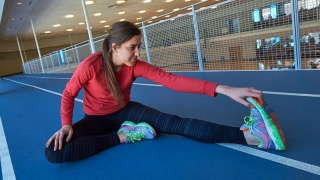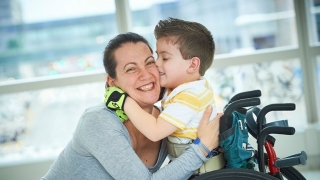Lower Cervical Spine Injuries: C3-C7
What are lower cervical spine injuries (C3-C7)?
The severity of injury to the cervical spine (the upper portion of the spine including the neck and just below the neck) depends on where the spine was damaged.
The bony spine protects a tube-like spinal column with its nerves that help control muscles to various sections of the body. The seven cervical vertebrae, at the top portion of the spine, have eight nerve pairs. This page deals with injuries to C3-C7 spine injuries.
Your child's spinal column is more elastic than the spinal column of an older people. This elasticity provides your child some protection against injury that might cause a fracture in older patients. The juvenile spine will stretch, but does not usually break; however, it can sustain serious injury.
Injuries to the cervical spine can produce varying results depending on the location of the injury and its severity. Some examples include:
- Injury to any one of the upper cervical nerves and/or the spinal cord may cause paralysis of some or all of the breathing muscles and possibly the arms and legs.
- Injury to the lower cervical nerves and/or the spinal cord may result in paralysis of the upper and lower extremities (arms and legs) and can cause bowel and bladder dysfunction.
The highest incidence of spinal injury occurs in adolescents and young adults 16-24 years old. Once patients reach 15-16 years old (and have generally reached skeletal maturity), spine injuries resemble those of adults.
The most common cervical spine injury in adolescents is at the C5 and C6 level.
Causes
The most common spinal cord injuries in the lower cervical spine occur as a result of:
- Birth injury
- Disease
- Motor vehicle accidents
- Falls
- Sports accidents
- Violence
Some additional causes of lower cervical spine injuries include:
- Lack of blood flow
- Compression from a blood clot or fractured bones
- Bending or buckling of ligaments
- Angulation (a sharp bending) of the spinal column
Testing and diagnosis
To diagnose lower cervical spine injuries, physicians at Children's Hospital of Philadelphia (CHOP) perform a comprehensive physical examination and detailed family history of the child.
We also use the following imaging tests to help determine your child’s diagnosis and the potential cause of the traumatic spine injury.
- X-rays, which use invisible electromagnetic energy beams to produce images of internal tissues, bones and organs on film
- Magnetic resonance imaging (MRI), which uses a combination of large magnets, radiofrequencies and a computer to produce detailed images of organs and structures within the body
- Computed tomography (CT) scan, which uses a combination of X-rays and computer technology to produce cross-sectional images (“slices”) of the body
Spine surgeons at CHOP have extensively studied the use of MRI in assessing cervical spine injuries, particularly for patients who are non-verbal or comatose. In some cases, the MRI uncovered additional injuries that X-rays did not document. With more detailed information, clinicians are able to create a customized treatment plan. Read the study abstract for details.
Treatments
Physicians treat lower cervical spine injuries with a variety of surgical and nonsurgical approaches. At CHOP, treatment recommendations depend on the location and severity of your child's injury, as well as other individual factors.
Treatment options include:
- Complete spine immobilization, including a rigid cervical collar
- An external brace such as a "halo" device, which consists of a metal ring fixed to your child's skull and connected to a padded vest by rigid bars
- Early administration of medication to prevent further injury to the spinal cord
- Surgical fusion, a surgical procedure to join two or more vertebrae, with or without using rigid metal devices
If your child needs surgery, we take every precaution to ensure safety in spine surgery. Our multidisciplinary approach helps us to address all aspects of your child’s care and treatment.
Surgery can improve traumatic spine injuries, but it can also be a stressful experience for you and your child. Our team can help you prepare your child for surgery and know what to expect during surgery.
Follow-up care
Anytime your child has sustained a spine injury, it is important to follow up with a physician. Careful and consistent ongoing care is essential to ensure your child is healing properly — whether your child had surgery or not.
Your child's physician will suggest a follow-up schedule for your child. Continuing care is available at CHOP's Main Campus or at a CHOP Care Network location.
Our pediatric clinical professionals will follow your child until young adulthood (between age 18 and 21) and help transition to adult orthopaedic care, if needed.
Long-term outcomes for lower cervical spine injuries
Long-term outcomes for pediatric patients with lower cervical spine injuries can vary greatly depending on the injury location and severity. At Children's Hospital, we work with you and your child to achieve the best possible outcome and quality of life for your child.






